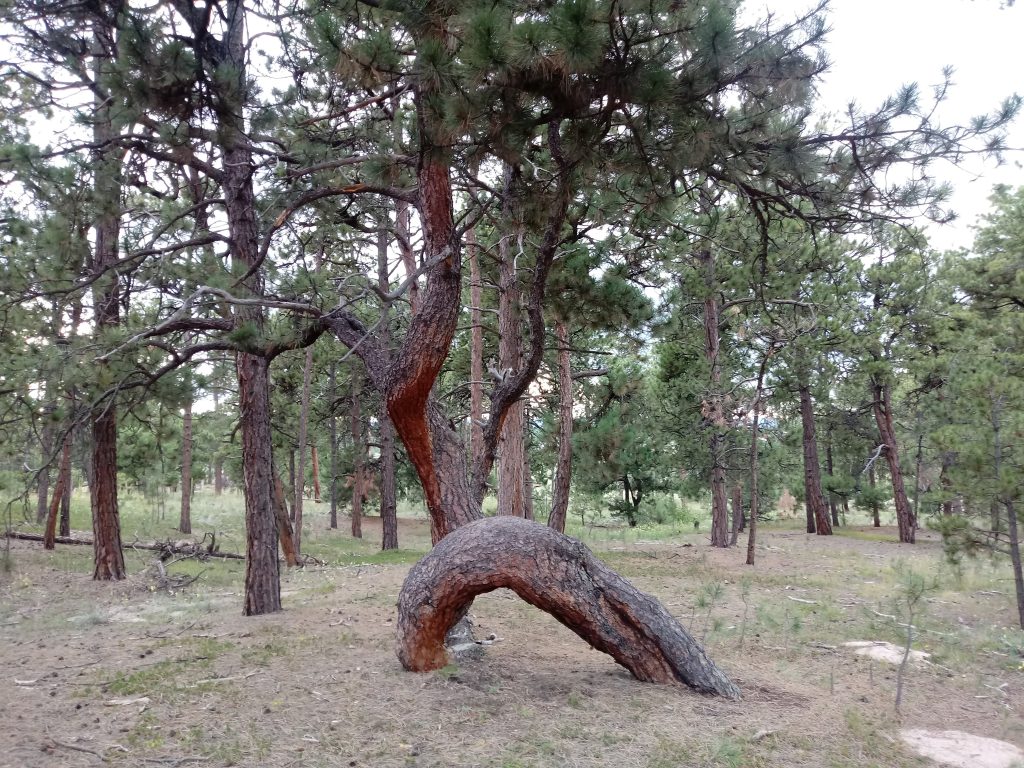By Janet Sellers
“There is fairly robust evidence that plant cells can perceive and respond to pressure waves, like the kind that are generated by sound in the environment and touch—like, say someone walking up to a tree and hugging it.”—
Ask Sam, the NHPR report by Sam Evans-Brown.
Pine trees are smart engineers.
Pine trees make their life with “smart materials.” Their leaves are needles, letting in sunshine but making snow fall through to the ground. The pine needles on the ground let rain and snowmelt sift through them to the earth and keep the moisture in, weed competition out. The pine tree can disperse essential protective oils from its bark and needles. This envelops and protects the forest, the wildlife, and us from various pathogens. The pine needles have nutrients the tree needs and recycle themselves to feed the forest. Underground is the Wood Wide Web of the forest.
The ponderosa can grow 200 feet tall or more, with girths up to 3 to 4 feet across. It is named for its ponderous (heavy) wood and is a major lumber tree in the Southwest. They reach maturity at 150 years and live 200-400 years; some were found as old as 600 to 800 years old. The oldest recorded ponderosas are 900 years old in the Utah WahWah Mountains.
A truly giving tree
Pine tree soil is specially made by and for pine trees. If we plan for it, the pine tree is our garden friend. We need to make rich soil for our intended plants via compost of those crop materials. We can enrich our soil needs for our gardens, and the pine tree’s needles will still protect our plants as mulch and water protection.
Pine cones close in wet weather to protect the seeds but open and disperse seeds in dry weather, keeping out pathogens. We can use the wood from our forest landscape (fire mitigation efforts of “dog hair” fallen trees and branches) to heat our homes in winter.

The pine pollen is edible and filled with protein, other nutrients, and even testosterone. Some studies show pine pollen may stimulate the immune system, boost brain health, support detoxification, promote weight loss, alleviate pain, and prevent some forms of cancer. Many men who take pine pollen believe that it can offer benefits such as improved athletic performance, greater muscle mass, and enhanced personal function of increased energy and libido. So, when spring rolls around and that yellow pollen is all over, we can celebrate first, then dust it off.
Janet Sellers is an ethnoecology researcher, writer, photographer, designer, artist, and chronicler of life and landscapes. She is director of Janet Sellers Fine Arts and lives near Monument, Colo. She can be contacted at janetsellers@ocn.me.
Other Hgh Altitude Nature and Gardening articles
- High Altitude Nature and Gardens – Wild Horse Fire Brigade: successful fire mitigation since the beginning of…plants (7/31/2025)
- High Altitude Nature and Gardening (HANG) – Gardening with nature’s beautiful bouncers (7/3/2025)
- High Altitude Nature and Gardening (HANG) – Enjoying nature in summer, high altitude landscaping, and weed control (6/7/2025)
- High Altitude Nature and Gardening (HANG) – May: new trees from tree branches, plant partners, bee kind (5/3/2025)
- High Altitude Nature and Gardening (HANG) – Earth Day and the joys of gardening (4/5/2025)
- High Altitude Nature and Gardening (HANG) – Wild outdoors: pine needle bread, gardening in March (3/1/2025)
- High Altitude Nature and Gardening (HANG) – Fermented February, cocoa mulch, and a chocolate “workout” (2/1/2025)
- High Altitude Nature and Gardening (HANG) – January is a seed starter month (1/4/2025)
- High Altitude Nature and Gardening (HANG) – Winter, our backyards, and forests (12/5/2024)
- High Altitude Nature and Gardening (HANG) – Let’s protect our forests, soil, and gardens (11/2/2024)

Leave a Comment